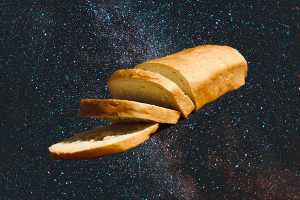
CUE THE FRENCH HORNS. Cue the starfield background. Cue the commanding male voice-over: “Bread … the boring frontier.” With apologies to fellow Star Trek fans, I think they would agree, bread is a rather uninteresting subject.
Every country, every culture uses grain products. And in most of those cultures, I would venture to say that the bread serves as a filler or a carrier of something else. But however it is served or consumed, it is always foundational. It is the basis for other parts of the meal … and the diet itself. Some languages even use “bread” as synonymous with or symbolic of food itself. In recent decades, the US FDA even chose it as the bottom layer of its ill-fated “Food Guide Pyramid.”
So when God chose to use bread as a picture of himself it was quite a powerful choice. The symbolism of bread is so profound, in fact, it serves as the ingredient (pun intended) for two opposite metaphors—which we’ll discuss in other blogs.
Old and New Testament Uses for the Same Symbol
“The way to a man’s heart is through his stomach” used to be a saying back in “the day” (whenever that was). In case my readers are not familiar with it, it implied that when courting, dating, or whatever word one uses, the way a woman could prove her love for a man and/or get a man to love her, was to cook delicious food for him.
Well, in God’s plan, he provided basic “bread” for his wilderness-wondering people shortly after their release from enslavement in Egypt. It was called “manna” (literally translated, ‘what’s this stuff?’) This strange life-giving substance that miraculously appeared each morning—except on the Sabbath, a miracle inside a miracle—was full of meaning as well as nutrition throughout the Old Testament. (Deuteronomy 8:16, Psalms 78:24, Nehemiah 9:20)
But God took his own metaphor even further in the New Testament, in the words and person of Jesus Christ. Jesus challenged the Jews by saying, “I am the bread of life. Your fathers ate the manna in the wilderness, yet they died. This is the bread that comes down from heaven, so that anyone may eat of it and not die. I am the living bread that came down from heaven. If anyone eats of this bread, he will live forever. And this bread, which I will give for the life of the world, is my flesh.” (John 6:48-51)
If I may play the part of an English teacher, that last verse even contains a mixed metaphor. And when Jesus added the symbol of eating his flesh, he further repulsed the Jews and drove away even some of his disciples. However, Jesus wasn’t insisting on some sort of mob cannibalism for his followers to obtain salvation. He was simply saying that our faith and our dependence on him must be as intrinsic a part of us as our body’s physical need for basic nourishment.